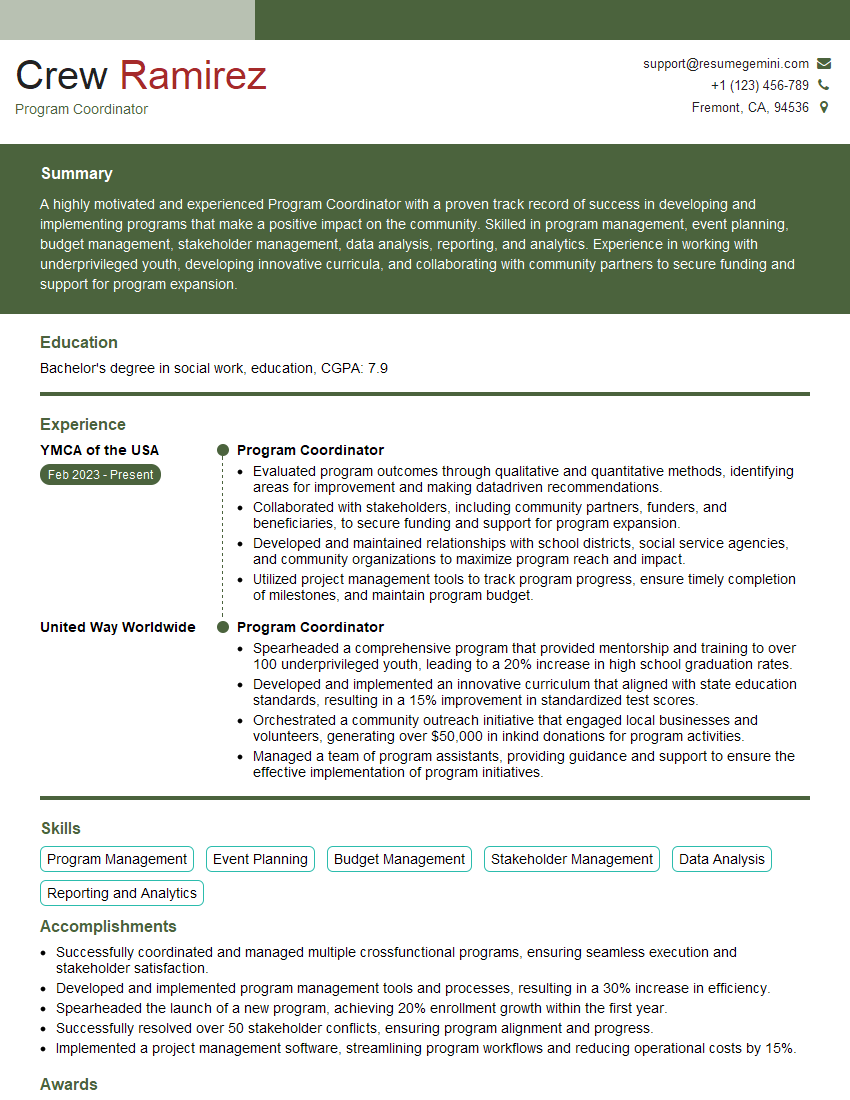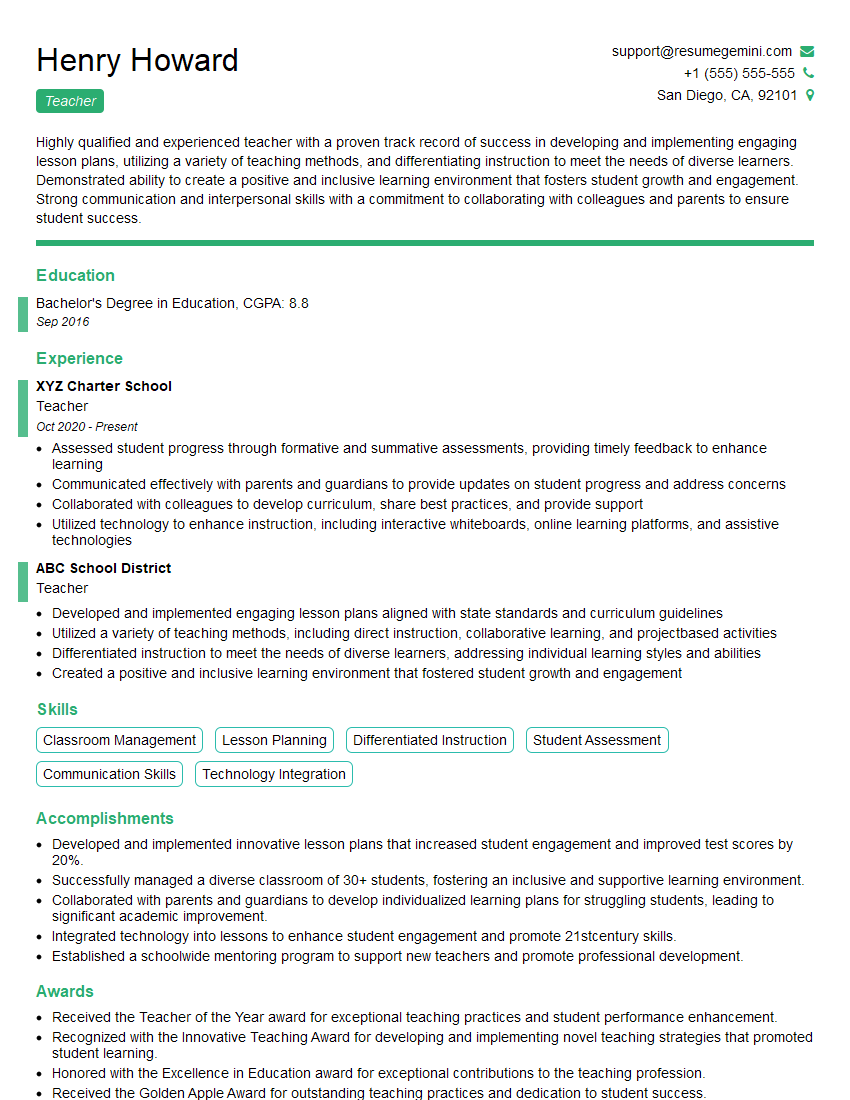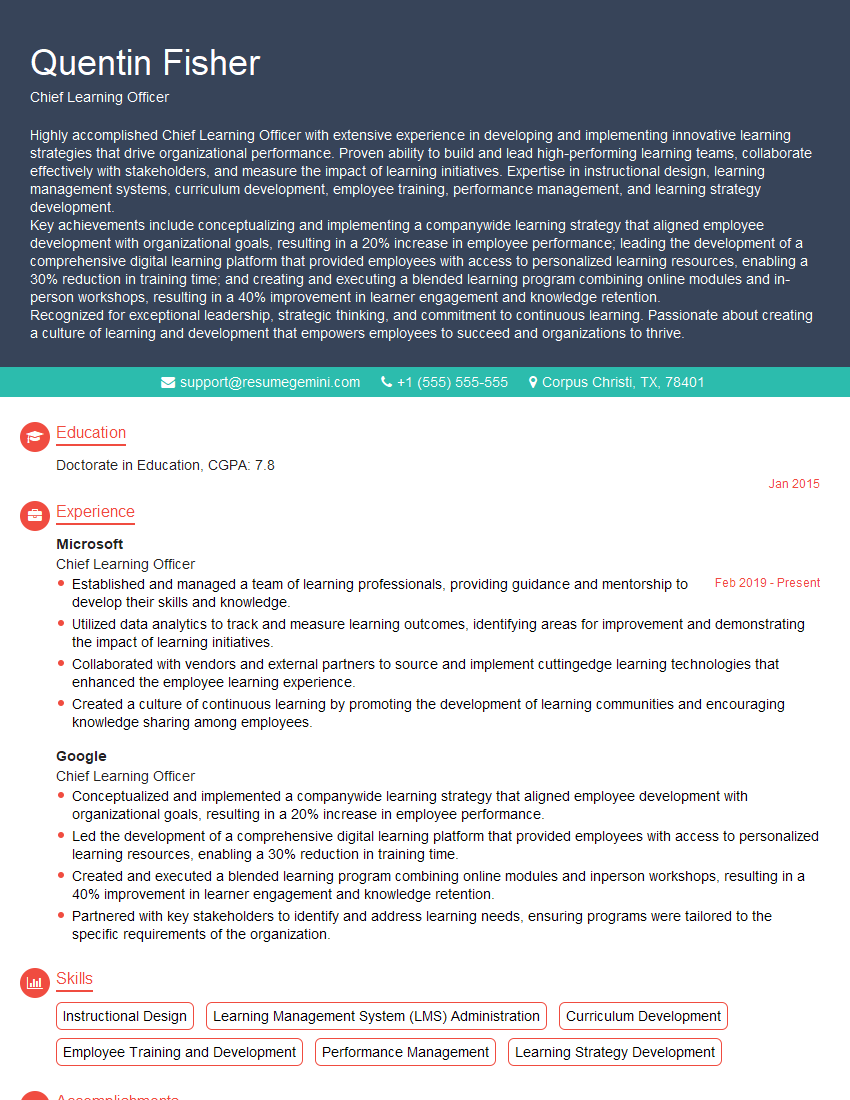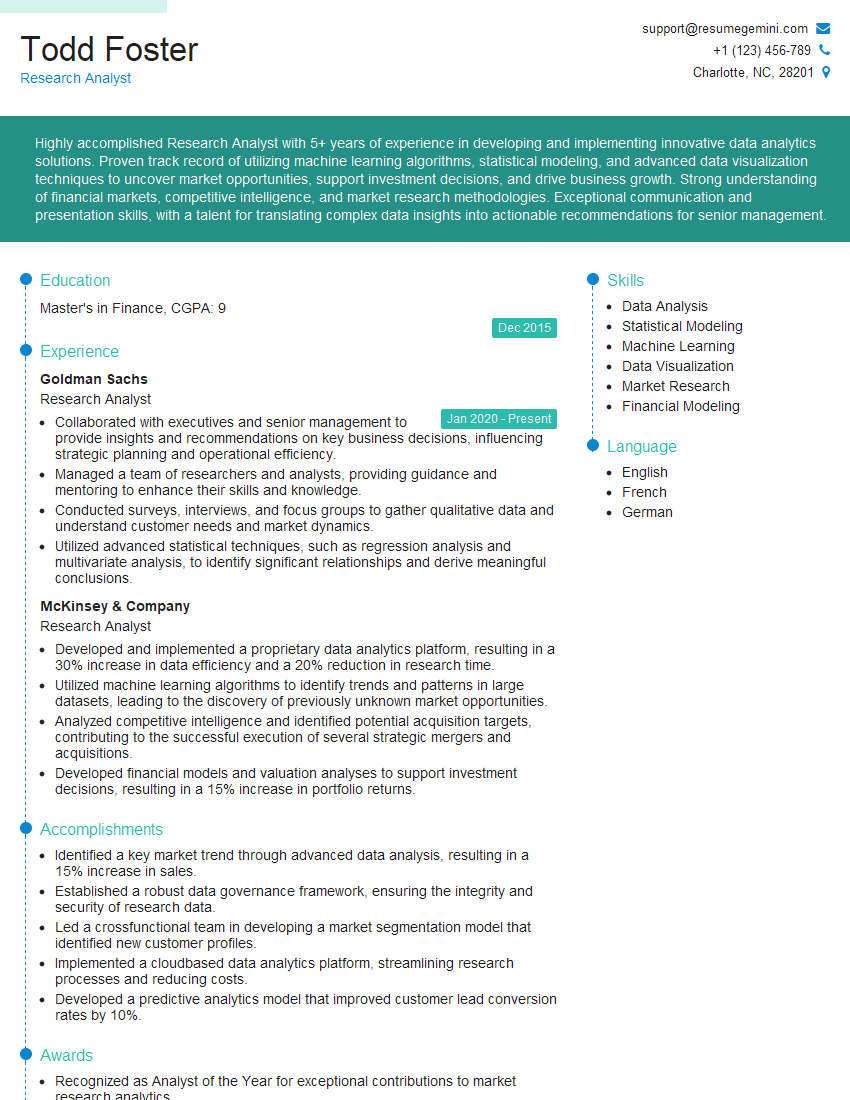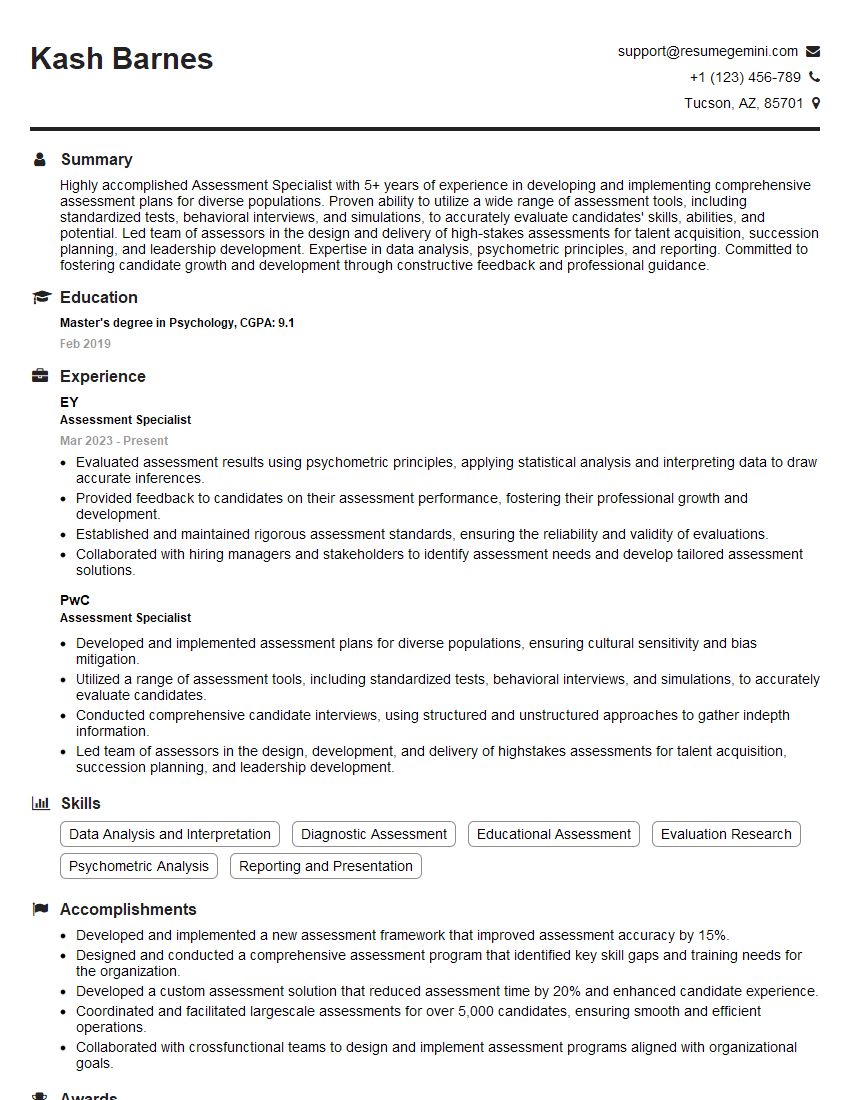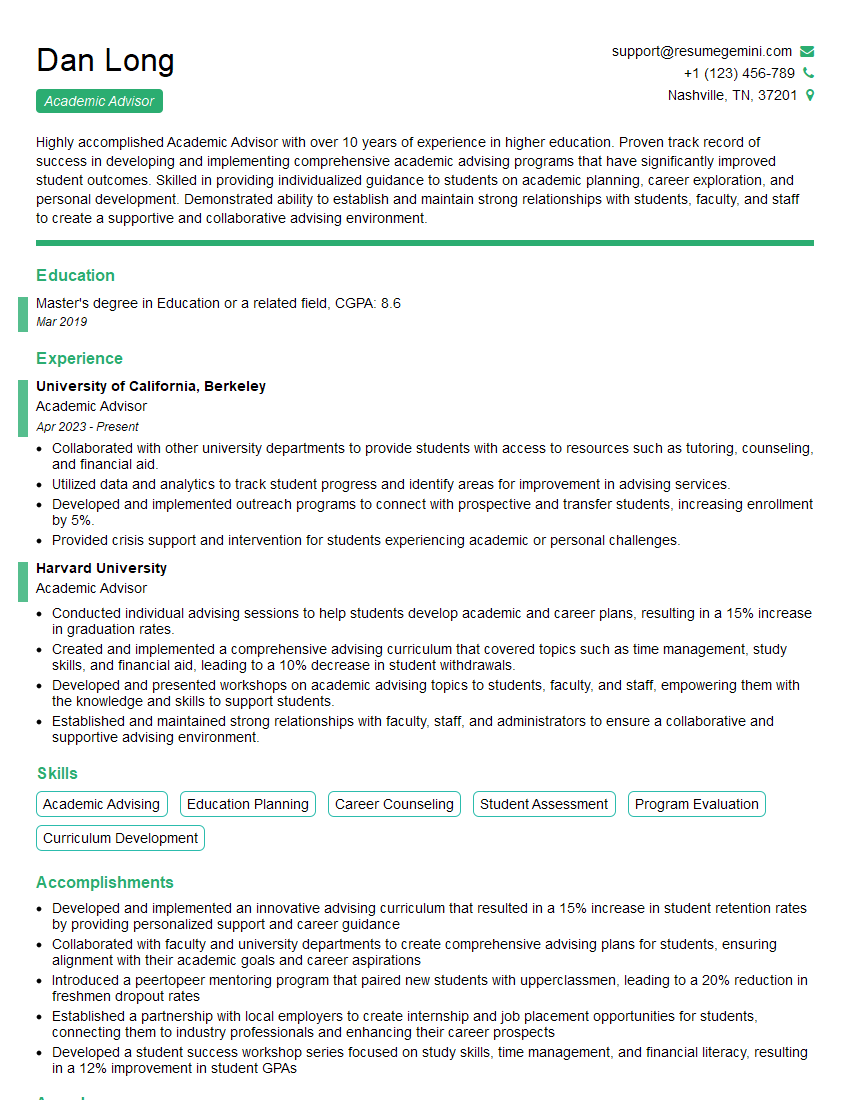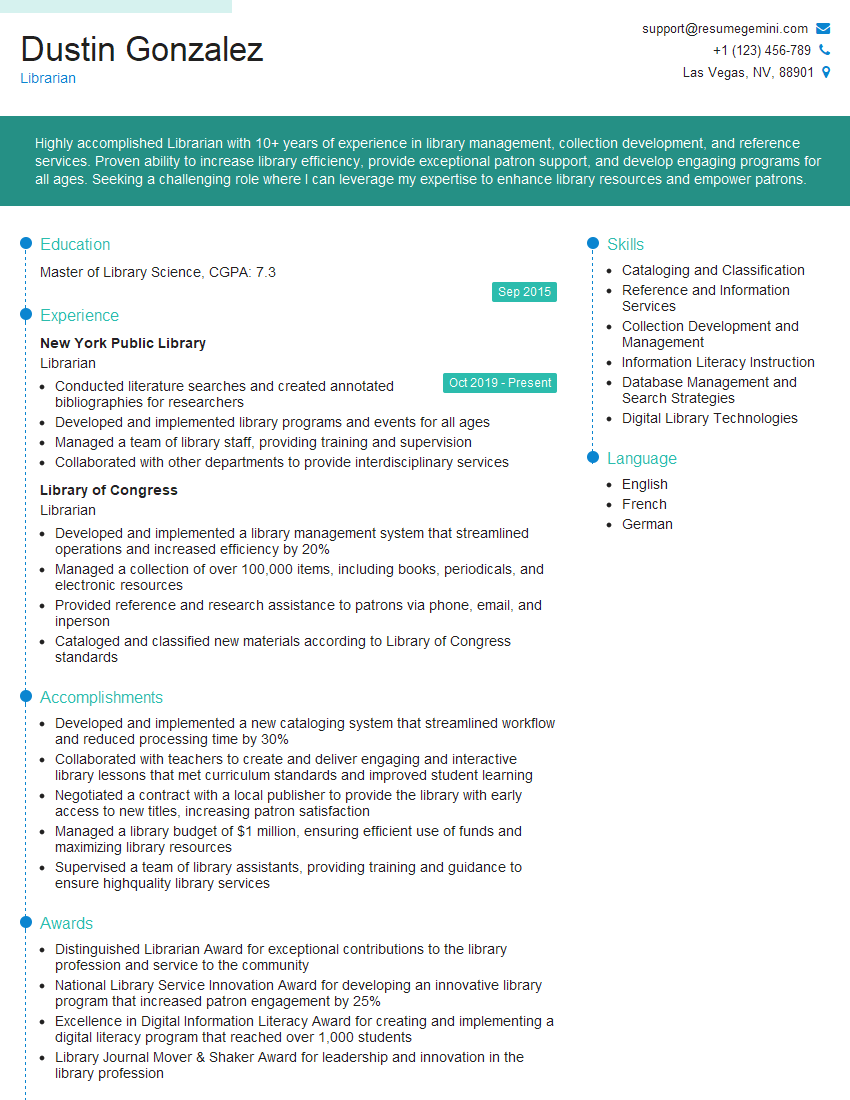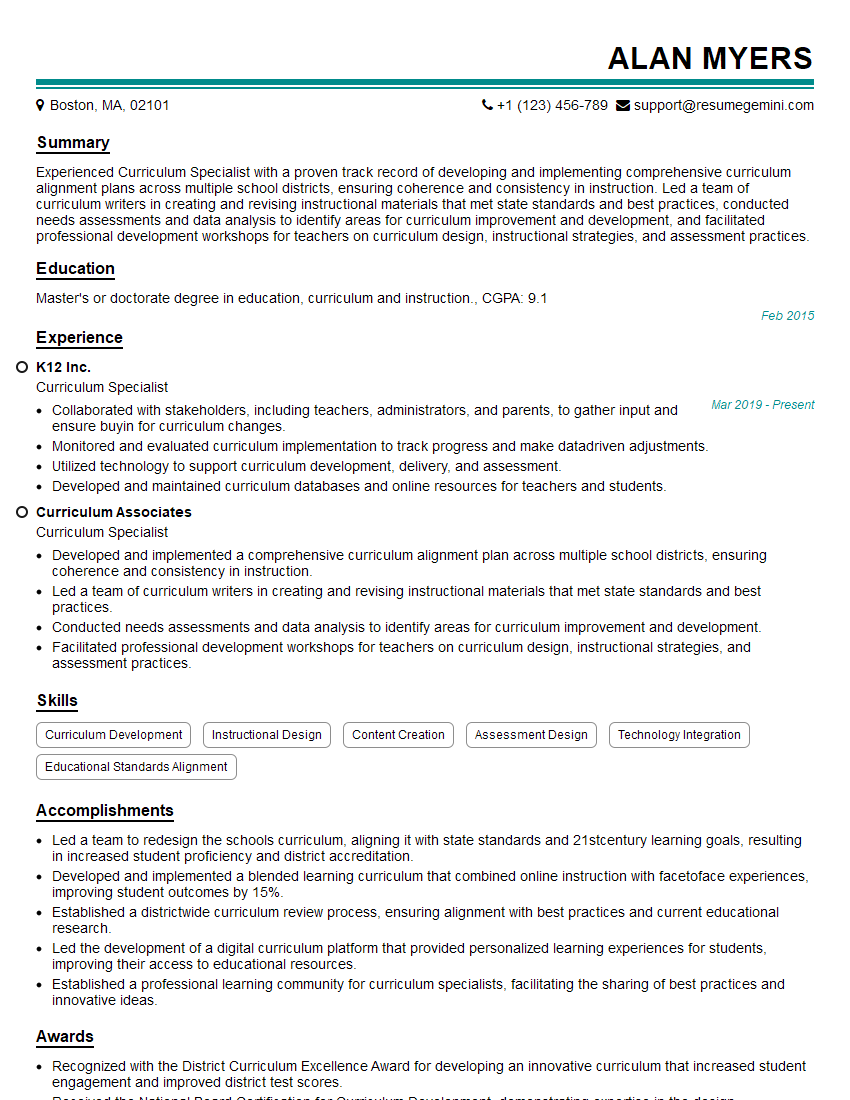Interviews are opportunities to demonstrate your expertise, and this guide is here to help you shine. Explore the essential InquiryBased Learning and Critical Thinking interview questions that employers frequently ask, paired with strategies for crafting responses that set you apart from the competition.
Questions Asked in InquiryBased Learning and Critical Thinking Interview
Q 1. Describe your experience designing inquiry-based learning activities.
Designing effective inquiry-based learning activities involves creating a structured environment where students actively explore questions and construct their understanding. It’s not just about assigning a project; it’s about carefully crafting the experience.
- Starting with a compelling question: The activity needs to begin with a question that genuinely sparks curiosity and is relevant to the learners. For example, instead of directly teaching about photosynthesis, I might begin with: “How do plants get their food?”
- Providing resources and scaffolding: Students need access to resources – books, articles, online tools, experiments – but the support should be carefully structured. Too much direction stifles inquiry; too little leaves learners adrift. I often use guiding questions or checklists to keep them on track.
- Designing opportunities for collaboration and discussion: Inquiry is a social process. I build in time for group work, debates, and presentations to encourage the sharing of ideas and perspectives.
- Integrating reflection and metacognition: Regular reflection helps students track their learning process and refine their thinking. Journaling prompts, peer feedback, and self-assessment activities are crucial.
- Connecting to real-world contexts: Inquiry-based learning is most effective when it’s relevant to students’ lives. I try to connect the learning to current events, community issues, or their personal experiences.
For instance, in a science class, I might design an inquiry-based project around investigating water pollution in a local river, allowing students to collect data, analyze results, and propose solutions. This engages them actively in the scientific method and connects their learning to their immediate environment.
Q 2. Explain the difference between deductive and inductive reasoning.
Deductive and inductive reasoning are two fundamental approaches to logical thinking. They differ in their direction of reasoning:
- Deductive reasoning starts with a general principle or theory and moves toward specific conclusions. It’s a top-down approach. If the premises are true, the conclusion *must* be true. For example: All men are mortal. Socrates is a man. Therefore, Socrates is mortal.
- Inductive reasoning begins with specific observations and moves toward a general conclusion or hypothesis. It’s a bottom-up approach. The conclusion is *likely* true, but not guaranteed. For example: Every swan I have ever seen is white. Therefore, all swans are white. (This is famously false, as black swans exist.)
Think of it like this: deduction is like using a recipe to bake a cake (following established rules to a guaranteed outcome), while induction is like noticing that every cake you’ve baked with butter has been moist and concluding that butter makes cakes moist (a likely, but not certain, conclusion).
Q 3. How do you foster critical thinking in a classroom/training setting?
Fostering critical thinking involves creating a classroom environment where students are encouraged to question, analyze, and evaluate information rather than simply memorizing facts. Here’s how I approach it:
- Ask open-ended questions: Instead of questions with simple yes/no answers, I pose questions that require deeper thought and analysis, such as “What are the different perspectives on this issue?”, or “What are the potential consequences of this action?”
- Encourage debate and discussion: Creating a safe space for respectful disagreement allows students to challenge their own assumptions and consider alternative viewpoints.
- Use diverse sources of information: Exposing students to various sources – including those with conflicting information – helps them learn to evaluate evidence critically.
- Model critical thinking: I demonstrate critical thinking skills in my own teaching by explicitly analyzing arguments, evaluating evidence, and acknowledging uncertainties.
- Provide opportunities for reflection: Journaling, self-assessment, and peer feedback encourage students to think about their own thinking processes.
For instance, in a history class, I might present students with multiple primary source accounts of a historical event and ask them to compare and contrast the accounts, identifying biases and evaluating the credibility of each source. This encourages critical analysis of historical narratives.
Q 4. What strategies do you use to assess students’/trainees’ critical thinking skills?
Assessing critical thinking skills requires moving beyond traditional methods like multiple-choice tests. I use a variety of strategies to gain a comprehensive understanding:
- Analyzing written work: Essays, research papers, and case study analyses provide insight into a student’s ability to synthesize information, construct arguments, and support claims with evidence.
- Observations during class discussions and debates: Observing students’ participation in discussions reveals their ability to articulate their thoughts, engage in reasoned argumentation, and respond to counterarguments.
- Portfolio assessments: Collecting student work over time – including drafts, revisions, and reflections – showcases their growth in critical thinking skills.
- Performance-based assessments: Tasks like presentations, debates, or problem-solving simulations allow students to demonstrate their skills in a more dynamic setting.
- Self and peer assessment: Students reflecting on their own critical thinking processes and providing feedback to peers helps improve metacognitive awareness.
I might, for example, ask students to analyze a complex social issue, present their analysis, and then defend their conclusions against challenges from their peers. This allows me to assess not only their understanding of the issue but also their ability to articulate their reasoning and respond to criticism.
Q 5. Describe a time you used inquiry-based learning to solve a complex problem.
In a professional development workshop focused on improving team communication, we faced a complex problem: a high turnover rate among newly hired staff. Instead of lecturing on communication strategies, I facilitated an inquiry-based approach.
We began with the question: “Why are we losing so many new hires so quickly?” Participants, divided into smaller groups, then explored various possible causes. They researched existing data (employee exit interviews, performance reviews), conducted informal interviews with current staff, and brainstormed potential contributing factors. Each group developed a hypothesis and designed a small-scale experiment to test their hypothesis. For example, one group hypothesized that insufficient onboarding contributed to the problem and designed an improved onboarding program. Another group focused on communication styles and tested different approaches to team meetings.
Through this process, the participants didn’t just learn about communication; they experienced the power of inquiry to solve a real-world problem within their own organization. The resulting solutions, developed through their own investigation, were far more impactful and effectively implemented than any pre-packaged solution could have been.
Q 6. How do you address misconceptions or biases in an inquiry-based learning environment?
Addressing misconceptions and biases in an inquiry-based learning environment is crucial for fostering objective thinking. I employ several strategies:
- Explicitly acknowledging biases: I openly discuss the existence of biases and how they can influence our interpretations. I emphasize that acknowledging bias is not an admission of weakness but a sign of intellectual honesty.
- Providing diverse perspectives: I ensure students are exposed to a range of viewpoints and sources of information, helping them develop a more nuanced understanding of the issue.
- Encouraging critical evaluation of sources: I guide students to examine the credibility of sources, identify potential biases, and consider the context in which information was produced.
- Facilitating respectful debate and discussion: Creating a safe space for students to express differing opinions and engage in respectful dialogue is essential for challenging biases.
- Using evidence-based reasoning: I emphasize the importance of basing conclusions on evidence rather than assumptions or preconceived notions.
For instance, when discussing a controversial historical event, I would present diverse primary source accounts and lead students to critically examine each source’s potential biases, ultimately building a more complete and nuanced understanding of the event, rather than accepting a single, potentially biased narrative.
Q 7. What are the limitations of inquiry-based learning?
While inquiry-based learning offers significant advantages, it’s important to acknowledge its limitations:
- Time-consuming: Inquiry-based learning takes more time than traditional lecture-based methods, requiring careful planning and dedicated class time for exploration and discussion.
- Requires significant preparation: Teachers need to carefully curate resources, design engaging activities, and develop effective scaffolding to support students’ learning.
- Not suitable for all topics or learning objectives: Some topics might lend themselves less readily to inquiry-based approaches, especially those requiring mastery of basic facts or procedures.
- Potential for off-task behavior: Without clear guidance and structure, students may stray from the intended learning objectives, requiring careful monitoring and redirection.
- Assessment challenges: Assessing student learning in an inquiry-based setting can be more complex than with traditional assessments, requiring creative approaches to evaluate critical thinking skills.
Therefore, successful implementation of inquiry-based learning requires careful planning, consideration of learning objectives, and a flexible approach to teaching and assessment.
Q 8. How do you differentiate instruction to meet the diverse learning needs of students?
Differentiation in education means tailoring instruction to meet the unique learning needs of each student. It recognizes that students learn at different paces, have varying strengths and weaknesses, and possess diverse learning styles. In an inquiry-based learning (IBL) environment, differentiation is crucial for maximizing engagement and success.
- Varying the complexity of the inquiry question: For example, in a science class exploring ecosystems, some students might investigate a specific species’ role, while others explore the entire ecosystem’s dynamics. This caters to different levels of prior knowledge and readiness.
- Offering diverse modes of inquiry: Some students thrive in group settings, others prefer individual work. Some might prefer hands-on experiments, others might prefer research and analysis. Providing options like these ensures every student has a suitable approach.
- Providing varied assessment opportunities: Not all students shine in traditional assessments. Offering a range of assessments – presentations, written reports, models, digital portfolios – allows students to demonstrate their learning in their preferred style.
- Utilizing flexible grouping strategies: Students can be grouped homogeneously (students of similar abilities working together) or heterogeneously (students with diverse abilities collaborating) to support learning and peer teaching.
For example, in a history class investigating the American Revolution, I might offer students a choice between creating a documentary, writing a historical fiction story, or designing an interactive museum exhibit, allowing them to showcase their learning through various modalities.
Q 9. Explain the role of questioning in promoting inquiry-based learning.
Questioning is the cornerstone of inquiry-based learning. It’s not about testing knowledge but about stimulating curiosity, prompting investigation, and guiding students towards deeper understanding. Effective questioning in IBL fosters critical thinking and problem-solving skills.
- Open-ended questions: These questions encourage exploration and don’t have a single right answer (e.g., “What are the potential consequences of climate change?”, “How might we improve this design?”).
- Probing questions: These delve deeper into a student’s thinking and reasoning (e.g., “Can you explain your reasoning?”, “What evidence supports your claim?”).
- Connecting questions: These link concepts and ideas, helping students see relationships (e.g., “How does this relate to what we learned yesterday?”, “What are the similarities and differences between these two approaches?”).
- Hypothetical questions: These encourage creative thinking and problem-solving by exploring ‘what if’ scenarios (e.g., “What would happen if…?”, “What are the potential benefits and drawbacks of…?”).
Imagine a class studying the solar system. Instead of lecturing on planets, I would begin with a question like, “What evidence suggests the existence of other planets beyond our solar system?” This open-ended question encourages students to research, analyze, and present their findings, leading to a much deeper understanding.
Q 10. How do you encourage collaboration and peer learning in an inquiry-based setting?
Collaboration and peer learning are essential components of successful inquiry-based learning. It mirrors real-world problem-solving where teamwork is often necessary. I foster collaboration through structured activities and a supportive classroom culture.
- Think-Pair-Share: Students think individually, discuss their ideas with a partner, then share with the larger group. This allows quieter students to participate and refine their thinking.
- Jigsaw activities: Students become experts on specific aspects of a topic and then teach their peers, promoting peer teaching and collaborative learning.
- Group projects: Carefully designed group projects with clear roles and responsibilities can enhance collaboration, requiring students to work together towards a common goal.
- Creating a culture of respect and trust: This is done through establishing classroom norms which emphasize respectful communication and collaboration. I regularly model this behavior and provide opportunities for students to practice.
For instance, when investigating the effects of pollution, I would divide students into groups, assigning each a different type of pollution to research. Each group becomes an expert and then presents their findings to the class, building a collaborative understanding of the topic.
Q 11. Describe your approach to scaffolding learning in an inquiry-based environment.
Scaffolding in IBL involves providing students with temporary support to help them navigate the challenges of independent inquiry. It’s about gradually releasing responsibility as students develop their skills and confidence.
- Modeling the inquiry process: Demonstrate the steps involved in asking a question, forming a hypothesis, gathering evidence, and drawing conclusions.
- Providing graphic organizers: These help students structure their thinking and organize information (e.g., KWL charts, concept maps).
- Offering checklists or rubrics: These give students clear expectations for their work and guide their progress.
- Providing targeted feedback: Offer constructive feedback on students’ work to help them refine their skills and address misconceptions.
- Breaking down complex tasks: Divide large assignments into smaller, more manageable parts, allowing students to build confidence incrementally.
For example, when tackling a complex research project, I might initially provide a structured outline, then gradually reduce the level of support as students become more adept at independent research. Providing regular feedback during the process helps them refine their approach and improve the quality of their work.
Q 12. How do you evaluate the effectiveness of inquiry-based learning activities?
Evaluating IBL effectiveness requires a multifaceted approach that goes beyond traditional standardized tests. It should focus on students’ understanding, critical thinking skills, and the inquiry process itself.
- Observations: Observe students’ engagement, collaboration, and problem-solving skills during inquiry activities.
- Student self-assessment: Have students reflect on their learning process, identify strengths and weaknesses, and suggest improvements.
- Peer assessment: Encourage students to provide feedback to each other, promoting metacognition and collaborative learning.
- Project-based assessments: Evaluate the quality of students’ research, analysis, and presentations, demonstrating their understanding of the concepts explored.
- Rubrics and checklists: Use clearly defined rubrics and checklists to provide feedback and assess students’ progress against specific learning objectives.
For instance, in a project on designing a sustainable city, I might assess students based on their research, their design proposal, their presentation, and their reflections on the challenges and learning process.
Q 13. What are some common challenges in implementing inquiry-based learning, and how do you overcome them?
Implementing IBL can present challenges, but proactive strategies can mitigate these issues.
- Time constraints: IBL often requires more time than traditional instruction. To address this, I carefully select inquiry questions, prioritize essential learning objectives, and utilize time-efficient activities.
- Managing student autonomy: Some students may struggle with self-directed learning. I provide clear guidelines, scaffolding, and regular check-ins to support students in managing their time and responsibilities.
- Assessment challenges: Assessing inquiry-based learning can be complex. By using a variety of assessment methods and clearly defined criteria, it’s possible to evaluate student learning effectively.
- Lack of resources: Access to sufficient materials and technology is crucial for IBL. Proactive planning and collaboration with school administrators are essential to secure necessary resources.
- Teacher training and support: Effective implementation requires professional development and ongoing support for teachers to implement inquiry-based strategies successfully.
For example, to overcome time constraints, I might focus on a smaller number of in-depth inquiry projects rather than attempting to cover many topics superficially. I also use technology to enhance efficiency, such as online collaboration tools and digital resources.
Q 14. How do you incorporate technology to enhance inquiry-based learning?
Technology can significantly enhance inquiry-based learning by providing access to vast resources, fostering collaboration, and enabling innovative modes of inquiry.
- Online research tools: Databases, digital libraries, and online encyclopedias provide access to a wealth of information.
- Collaboration platforms: Tools like Google Docs, Microsoft Teams, or Padlet facilitate group work and communication.
- Data analysis tools: Spreadsheets, statistical software, and data visualization tools empower students to analyze data and draw conclusions.
- Simulation and modeling software: These tools allow students to explore complex systems and phenomena virtually.
- Digital storytelling and presentation tools: Students can create engaging presentations, videos, and interactive exhibits to showcase their findings.
For example, students researching climate change can use online databases to access climate data, use mapping software to visualize changes, and use presentation software to share their findings in an engaging way. Simulation software can also allow students to model the impacts of different mitigation strategies.
Q 15. How do you ensure that inquiry-based learning activities are aligned with learning objectives?
Aligning inquiry-based learning with learning objectives is crucial for ensuring students develop the intended knowledge and skills. It’s not about simply letting students explore; it’s about guiding their exploration towards specific, measurable goals. This alignment begins with carefully crafting learning objectives that are clear, concise, and measurable using a framework like Bloom’s Taxonomy.
For example, instead of a vague objective like “understand photosynthesis,” a better objective would be “Students will be able to explain the process of photosynthesis, including the roles of light, chlorophyll, and carbon dioxide, and illustrate the process diagrammatically.” This allows you to design inquiry-based activities that directly address these specific components.
- Backward design: I begin by defining the desired learning outcomes. Then, I design inquiry-based activities that directly lead students to achieve these outcomes. This might involve posing a driving question that requires students to investigate the different aspects of photosynthesis.
- Activity selection: I choose activities that require students to actively engage with the material through research, experimentation, or debate, all designed to answer the driving question and meet the learning objectives.
- Assessment integration: The assessment should directly measure the achievement of the learning objectives. This could include lab reports, presentations, debates, or even creating their own teaching resources to demonstrate their understanding.
By meticulously aligning activities, assessments, and objectives, I ensure that the inquiry process is purposeful and effective, resulting in demonstrable student learning.
Career Expert Tips:
- Ace those interviews! Prepare effectively by reviewing the Top 50 Most Common Interview Questions on ResumeGemini.
- Navigate your job search with confidence! Explore a wide range of Career Tips on ResumeGemini. Learn about common challenges and recommendations to overcome them.
- Craft the perfect resume! Master the Art of Resume Writing with ResumeGemini’s guide. Showcase your unique qualifications and achievements effectively.
- Don’t miss out on holiday savings! Build your dream resume with ResumeGemini’s ATS optimized templates.
Q 16. Describe a time you had to adapt an inquiry-based learning plan based on student/trainee needs.
In a recent module on climate change, I initially planned a large-scale research project where students would choose their own research questions and conduct extensive independent research. However, I quickly realized that several students lacked the necessary research skills and confidence to work independently. Their initial struggles with identifying credible sources and formulating focused research questions hindered their progress.
To adapt, I changed my approach. I structured the project into smaller, more manageable stages. We began with a series of guided research activities focused on evaluating different types of information sources. This involved analyzing websites for bias and credibility, learning how to properly cite sources, and understanding the difference between facts and opinions. We also practiced formulating research questions together, using brainstorming techniques and peer feedback. We then moved to smaller group projects focused on specific aspects of climate change, providing scaffolding and support through regular check-ins and feedback.
This adjusted plan improved student engagement and participation significantly. Students felt more confident in their research process and produced higher quality work. This experience highlighted the importance of flexibility and responsiveness to students’ individual needs within an inquiry-based framework.
Q 17. What are some effective techniques for promoting analytical thinking?
Promoting analytical thinking requires a multifaceted approach focusing on developing critical thinking skills and moving beyond simple recall and comprehension. Several techniques are particularly effective:
- Socratic questioning: Instead of lecturing, I guide students using open-ended questions that encourage them to think deeply and critically about concepts. This helps them to justify their reasoning and identify assumptions.
- Case studies: Real-world case studies provide opportunities for analyzing complex situations, identifying underlying issues, and evaluating potential solutions. This allows students to apply their knowledge in a practical context.
- Debate and argumentation: Structured debates encourage students to critically examine different perspectives, formulate arguments, and support their claims with evidence. This cultivates their ability to construct well-reasoned arguments.
- Data analysis activities: Activities involving the analysis of data, whether quantitative or qualitative, help students develop analytical skills, interpretation abilities, and the ability to draw evidence-based conclusions.
- Reflection prompts: Regular reflection exercises help students consolidate their learning and deepen their understanding by prompting them to articulate their thought processes and identify areas for improvement.
These methods work in conjunction to nurture analytical thinking, moving beyond surface-level understanding to encourage deeper engagement and critical evaluation of information.
Q 18. How do you teach students/trainees to evaluate sources of information critically?
Teaching students to evaluate sources critically is crucial in today’s information-saturated world. My approach involves both direct instruction and practical application.
- Identifying biases: We discuss various types of biases (confirmation bias, authority bias, etc.) and how they can affect information presented. I use examples from current events to show how bias manifests in different news sources.
- Evaluating authorship and credibility: Students learn to assess the credibility of authors and organizations by examining their credentials, affiliations, and potential conflicts of interest. This involves exploring the ‘About Us’ sections of websites and researching the authors’ backgrounds.
- Fact-checking and source verification: We practice fact-checking techniques, using multiple sources to verify information and looking for corroborating evidence. This includes learning how to use fact-checking websites and evaluating the quality of evidence.
- Recognizing propaganda and misinformation: We discuss techniques used in propaganda and misinformation campaigns and practice identifying these techniques in various media formats. This includes analyzing the use of emotionally charged language, misleading statistics, and logical fallacies.
- Analyzing source context: Students understand the importance of considering the context in which information is presented. We examine the publication date, audience, and intended purpose of a source.
By combining direct instruction with hands-on practice, I equip students with the skills to navigate the complexities of information evaluation effectively. We use a combination of online resources and real-world examples to make learning engaging and applicable.
Q 19. How do you encourage students/trainees to develop their own research questions?
Developing the ability to formulate research questions is a cornerstone of effective inquiry. I use a multi-step approach:
- Brainstorming and idea generation: I start by engaging students in brainstorming sessions, using techniques like mind-mapping and freewriting to generate a wide range of potential topics. This allows them to explore their interests and discover areas they’d like to investigate further.
- Focusing the scope: Once students have several ideas, we work together to narrow their focus and develop more specific, researchable questions. This involves discussing the feasibility of investigating each question, considering the available resources and time constraints.
- Formulating questions using appropriate frameworks: We practice crafting research questions using different frameworks, such as the PICO framework (Population, Intervention, Comparison, Outcome) for research in healthcare or other relevant frameworks depending on the subject matter. This helps students structure their questions effectively.
- Refining questions through peer review: Students share their questions with peers and receive feedback on clarity, feasibility, and focus. This collaborative process helps them refine their questions and identify areas for improvement.
- Connecting questions to broader themes: Finally, I encourage students to connect their individual research questions to larger, thematic issues relevant to the course or subject matter. This helps them understand the context and significance of their investigations.
This multi-stage process helps students gradually develop the skills needed to formulate clear, focused, and meaningful research questions.
Q 20. Describe your approach to fostering intellectual curiosity.
Fostering intellectual curiosity involves creating a learning environment that values questioning, exploration, and critical thinking. It’s not simply about imparting information; it’s about igniting a passion for learning.
- Creating a safe space for questioning: I establish a classroom culture where students feel comfortable asking questions, even those that may seem unconventional or challenging. I actively encourage questioning and demonstrate genuine interest in their inquiries.
- Connecting learning to real-world contexts: I connect learning to real-world issues and current events. This makes learning relevant and motivating, sparking students’ natural curiosity about the world around them.
- Incorporating elements of surprise and intrigue: I use engaging storytelling, unexpected demonstrations, or thought-provoking puzzles to capture students’ attention and pique their interest. This creates a sense of wonder and encourages exploration.
- Providing opportunities for self-directed learning: I give students choices in their learning, allowing them to pursue topics of particular interest. This fosters a sense of ownership and responsibility, encouraging deeper engagement.
- Modeling intellectual curiosity: I openly share my own intellectual curiosity and enthusiasm for learning, demonstrating that the pursuit of knowledge is a lifelong journey.
By creating a stimulating and supportive environment, I encourage students to embrace a lifelong love of learning and the pursuit of knowledge.
Q 21. Explain how you would address a student/trainee who is struggling with critical thinking.
Addressing a student struggling with critical thinking requires patience, understanding, and a tailored approach. It’s crucial to identify the root cause of the difficulty.
Step 1: Identify the challenge: Is it a lack of knowledge, understanding of concepts, or a lack of confidence? I’d have a conversation with the student, asking about their difficulties and actively listening to their perspective. This might involve asking open-ended questions such as: “What part of this assignment or topic is causing you the most difficulty?” or “How would you describe your approach to analyzing this problem?”
Step 2: Targeted support: Once the challenge is identified, I would provide specific support. If the issue is a lack of foundational knowledge, I’d offer additional resources or remedial instruction. If it’s a lack of confidence, I might use small group activities or peer mentoring. If the challenge lies in their critical thinking skills, I’d provide explicit instruction on critical thinking techniques, such as identifying assumptions, evaluating evidence, or recognizing logical fallacies. I might provide structured exercises, gradually increasing the complexity.
Step 3: Feedback and iteration: I would provide regular, constructive feedback on the student’s work, emphasizing their strengths and areas for improvement. This involves showing them how to analyze their own work critically and identify areas where they can strengthen their arguments or analysis. This is an iterative process – regular check-ins and adjustments will be necessary to ensure progress.
Step 4: Celebrate small wins: Recognizing and celebrating small improvements is essential to build the student’s confidence and motivation. This will reinforce their progress and encourage them to continue striving towards improved critical thinking skills.
Ultimately, my goal is to empower the student to become a more confident and effective critical thinker through targeted support, tailored instruction, and consistent encouragement.
Q 22. How do you create a supportive and inclusive learning environment that encourages risk-taking and critical discussion?
Creating a supportive and inclusive learning environment that fosters risk-taking and critical discussion hinges on establishing a culture of respect, trust, and psychological safety. This means students feel comfortable sharing their ideas, even if they’re incomplete or unconventional, without fear of judgment or ridicule.
- Establish clear guidelines: Begin by explicitly stating expectations for respectful communication and active listening. This could include a class charter co-created with the students themselves.
- Structured discussions: Utilize techniques like Think-Pair-Share or Fishbowl debates to provide a scaffold for discussion and ensure all voices are heard. These structures reduce the pressure on individual students to contribute immediately and allow for preparation and reflection.
- Embrace diverse perspectives: Actively encourage students to consider different viewpoints and challenge their own assumptions. This can be done through incorporating diverse sources and perspectives into the learning materials.
- Non-judgmental feedback: Frame feedback as a process of collaborative improvement, focusing on the reasoning and thought process rather than simply judging the correctness of the answer. Ask guiding questions like, “What led you to that conclusion?” or “Can you elaborate on that point?”
- Celebrate mistakes as learning opportunities: Frame errors not as failures but as valuable opportunities for growth and refinement of understanding. This encourages students to experiment and take intellectual risks without fearing negative consequences.
For instance, in a history class discussing the causes of World War I, students might initially hold strongly contrasting views. By using a structured debate format and emphasizing respectful dialogue, students can engage in a robust exchange of ideas, ultimately leading to a deeper and more nuanced understanding of the topic.
Q 23. How do you use feedback to promote critical reflection and learning?
Feedback is most effective when it’s specific, timely, and focuses on both the process and the product. It shouldn’t just tell students if they’re right or wrong, but rather help them understand *why* they arrived at a particular answer and how they can improve their thinking.
- Descriptive feedback: Instead of simply saying “Incorrect,” provide specific feedback on the student’s reasoning. For example, “Your analysis of the data was insightful, but your conclusion didn’t fully account for variable X.” This approach is much more helpful than a generic comment like “good job” or “try again.”
- Self and peer assessment: Encourage students to reflect on their own work and provide feedback to their peers. This promotes metacognition and helps students develop their ability to evaluate and refine their thinking. Rubrics and checklists are particularly useful tools in this respect.
- Focus on the process: Assess not only the final answer, but also the steps taken to reach that answer. Did the student use logical reasoning? Did they consider alternative perspectives? Did they evaluate the evidence critically?
- Growth mindset feedback: Emphasize that intelligence and critical thinking skills are not fixed but can be developed through effort and practice. This fosters a positive learning environment and encourages persistence.
Imagine a student writing an essay arguing a particular historical interpretation. Instead of simply giving a grade, feedback might highlight the strength of their evidence selection in some areas while suggesting further research to strengthen their argument in other sections, emphasizing the importance of considering alternative viewpoints.
Q 24. What are some examples of effective critical thinking frameworks or models?
Several frameworks can support critical thinking. These models provide structured approaches to analyzing information, forming arguments, and evaluating conclusions. Here are a few examples:
- Bloom’s Taxonomy: This hierarchical model outlines levels of cognitive complexity, from remembering and understanding to analyzing, evaluating, and creating. It helps to guide the design of learning activities and assessment tasks to promote higher-order thinking skills.
- The Toulmin Model of Argumentation: This model breaks down arguments into their core components: claim, data, warrant, backing, qualifier, and rebuttal. It helps students to construct and analyze arguments in a more rigorous and systematic way.
- The Socratic Method: This approach uses a series of probing questions to help students critically examine their beliefs and assumptions. It is particularly effective in prompting deep reflection and challenging preconceived notions.
- The Six Thinking Hats (Edward de Bono): This model encourages individuals to consider a problem from multiple perspectives by adopting different “thinking hats,” representing different modes of thinking such as emotional, logical, creative, and critical.
For example, when analyzing a scientific research paper, students might use the Toulmin model to identify the claim, evidence, and reasoning, while also evaluating the limitations and potential biases of the study using Bloom’s Taxonomy as a guide for the depth of their analysis.
Q 25. How do you assess students’/trainees’ ability to synthesize information and draw conclusions?
Assessing the ability to synthesize information and draw conclusions requires going beyond simple recall and comprehension. Assessments should focus on the student’s capacity to integrate various pieces of information, identify patterns, and develop well-supported conclusions.
- Case studies: Present students with complex scenarios requiring them to synthesize information from multiple sources to arrive at a solution or informed decision.
- Research projects: Assign projects that necessitate gathering data from diverse sources, analyzing it, and forming evidence-based conclusions. This could involve analyzing data sets, conducting interviews, or researching primary sources.
- Problem-solving tasks: Pose open-ended problems that require students to use their critical thinking skills to develop creative solutions, with a focus on the reasoning and justification provided.
- Debate or discussion: Evaluate students’ ability to synthesize information and draw conclusions during class discussions and debates. Look for evidence of thoughtful consideration of multiple perspectives and the capacity to support their arguments with evidence.
- Essays or reports: Assign essays or reports that require students to integrate information from multiple sources and present a well-supported argument or analysis.
For example, in a science class, students might be given data from different experiments and asked to synthesize these findings to draw conclusions about the relationship between two variables. The evaluation would focus not only on the correctness of their conclusion but also on the clarity and logic of their reasoning and the thoroughness of their synthesis.
Q 26. Explain the importance of metacognition in inquiry-based learning and critical thinking.
Metacognition, or “thinking about thinking,” is crucial for both inquiry-based learning and critical thinking. It involves awareness and understanding of one’s own thought processes, including strategies for learning, problem-solving, and self-regulation.
- Self-monitoring: Students who are metacognitively aware can monitor their understanding of a topic and adjust their learning strategies accordingly. If they find themselves struggling with a concept, they can identify the source of their difficulty and seek help or use different learning methods.
- Self-regulation: Metacognition allows students to control their cognitive processes, manage their time effectively, and stay focused on their learning goals. They can plan their learning, monitor their progress, and adjust their strategies as needed.
- Reflection: Regular reflection on their learning experiences helps students to identify what worked well and what didn’t, allowing them to refine their learning strategies for future endeavors. Journaling, reflective essays, or discussions are useful tools for this.
- Strategic planning: Metacognitive skills enable students to plan their approach to learning and problem-solving. They are better able to break down complex tasks into smaller, manageable steps, and to select appropriate strategies for different situations.
For instance, a student working on a research project might regularly reflect on their progress, identify areas where they need further research, and adjust their approach as needed. This metacognitive awareness enhances their ability to learn effectively and produce high-quality work.
Q 27. How do you integrate critical thinking into various subject areas or training programs?
Integrating critical thinking across subject areas involves designing learning experiences that encourage students to question, analyze, evaluate, and synthesize information, regardless of the specific content. This requires a shift from rote memorization to active engagement with the material.
- Problem-based learning: Pose real-world problems that require students to apply their knowledge and critical thinking skills to develop solutions. This approach can be used effectively across subjects, from science and engineering to history and literature.
- Inquiry-driven activities: Encourage students to ask questions, investigate answers, and evaluate the validity of their findings. This promotes a sense of ownership over the learning process and deepens understanding.
- Source evaluation: Teach students how to critically evaluate different sources of information, considering credibility, bias, and context. This is especially important in a digital age with a proliferation of readily available information.
- Reflective writing and journaling: Encourage students to reflect on their learning experiences and analyze their own thinking processes. This can be done through journaling, reflective essays, or discussions.
For example, in a literature class, students might analyze the author’s use of language and symbolism, evaluating the effectiveness of these techniques and considering different interpretations of the text. In a math class, they might be presented with a complex problem that requires them to break it down, select appropriate strategies, and justify their solution.
Key Topics to Learn for Inquiry-Based Learning and Critical Thinking Interviews
- Defining Inquiry-Based Learning (IBL): Understanding the core principles of IBL, its variations (e.g., guided inquiry, open inquiry), and its theoretical foundations (e.g., constructivism, sociocultural theory).
- The Role of Questions in IBL: Mastering the art of formulating effective inquiry questions (open-ended, probing, clarifying), analyzing student questions, and facilitating productive discussions.
- Critical Thinking Frameworks: Familiarize yourself with various critical thinking models (e.g., Bloom’s Taxonomy, Toulmin’s Model of Argumentation) and their application in IBL contexts.
- Practical Applications of IBL: Explore real-world examples of IBL implementation across diverse educational settings and disciplines. Consider case studies and best practices.
- Assessment in IBL: Understand how to effectively assess student learning within an IBL framework, moving beyond traditional testing methods to authentic assessments.
- Problem-Solving Strategies within IBL: Discuss approaches to fostering problem-solving skills, including identifying problems, formulating hypotheses, gathering evidence, and drawing conclusions.
- Ethical Considerations in IBL: Understand the ethical implications of inquiry-based learning, particularly regarding issues of bias, fairness, and student autonomy.
- Technology Integration in IBL: Explore how technology can enhance and support inquiry-based learning experiences.
Next Steps
Mastering Inquiry-Based Learning and Critical Thinking is crucial for success in today’s dynamic job market. These skills demonstrate your ability to solve complex problems, think creatively, and adapt to new challenges – highly valued attributes across various professions. To maximize your job prospects, focus on building an ATS-friendly resume that clearly showcases these skills. ResumeGemini is a trusted resource to help you create a professional and impactful resume that highlights your unique strengths. We provide examples of resumes tailored to Inquiry-Based Learning and Critical Thinking roles to help guide you through the process. Take advantage of these resources to present your qualifications effectively and land your dream job.
Explore more articles
Users Rating of Our Blogs
Share Your Experience
We value your feedback! Please rate our content and share your thoughts (optional).
What Readers Say About Our Blog
Take a look at this stunning 2-bedroom apartment perfectly situated NYC’s coveted Hudson Yards!
https://bit.ly/Lovely2BedsApartmentHudsonYards
Live Rent Free!
https://bit.ly/LiveRentFREE
Interesting Article, I liked the depth of knowledge you’ve shared.
Helpful, thanks for sharing.
Hi, I represent a social media marketing agency and liked your blog
Hi, I represent an SEO company that specialises in getting you AI citations and higher rankings on Google. I’d like to offer you a 100% free SEO audit for your website. Would you be interested?


